Traumatic Brain Injury Statistics and Brain Injury Facts
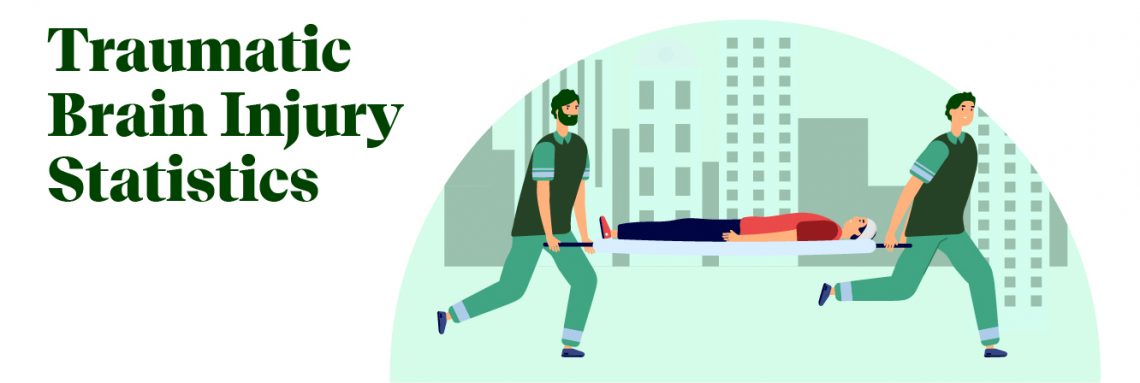
A brain injury is anything that adversely affects the brain’s functioning.
A hard fall with a blow to the head, a small vehicle accident involving whiplash, or a sports injury resulting in a concussive event, are all some instances that may result in a traumatic brain injury (TBI).
This type of head injury can be hard to diagnose and detect. In fact, you may be surprised to hear that falling unconscious is not a prerequisite for a traumatic brain injury diagnosis. Sometimes only a part of the brain is impacted and symptoms may show up much later while other times the primary blow causing the trauma leads to serious bleeding and immediately detectable damage. This type of injury can be incredibly traumatic and life-altering.
17 Brain Injury Facts
You never know when a fall, accident, or other incidents may occur that could result in this sort of injury, but it can be helpful to understand the risks surrounding traumatic brain injuries by learning some of the facts.
1. About 2.9 million Americans were diagnosed with a TBI in the span of one year.
This accounts for diagnoses made following emergency department visits in 2014. (Source: CDC)
2. Falls are the most common cause of TBI hospitalizations.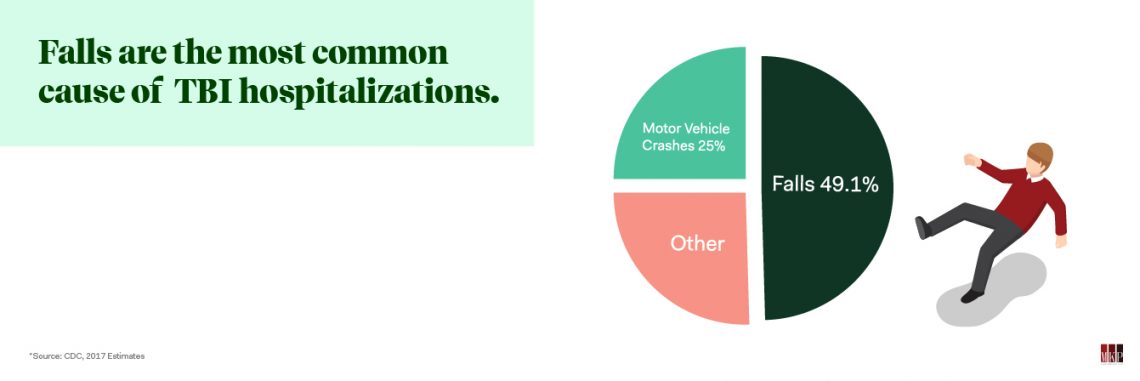
Falls account for an estimated 49.1% of all TBI-related hospitalizations and motor vehicle crashes account for about 25%. (Source: CDC)
3. Brain injuries kill.
In 2017, the most recent data available, there were 61,000 deaths related to traumatic brain injuries. (Source: CDC)
4. Age is a significant factor in TBI-related deaths.
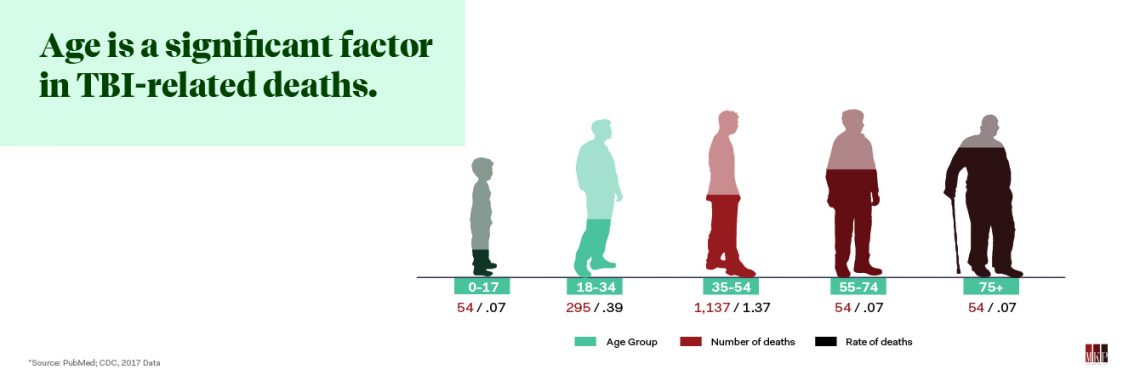
Fall-related TBIs have the highest rates of death for those 75+ at 54 out of every 100,000. That is 8x higher than the rate for those aged 55-74. (Source: CDC)
5. Head injury is a significant risk factor for dementia.
History of a single head injury was associated with 1.25 times increased risk of dementia and history of 2 or more head injuries was associated with a 2 times increased risk of dementia. (Source: Penn Medicine Research)
6. Men are more likely to sustain traumatic brain injuries.

Unintentional falls are the most common mechanism causing TBIs in males. Compared to women, men are twice as likely to suffer from a TBI caused by a motor vehicle accident, having been struck by an object, or from intentional self-harm and over 4x more likely to have a TBI resulting from an assault. (Source: CDC Surveillance Report for 2017)
7. Vehicle-related brain injury is highest for those aged 15-34.
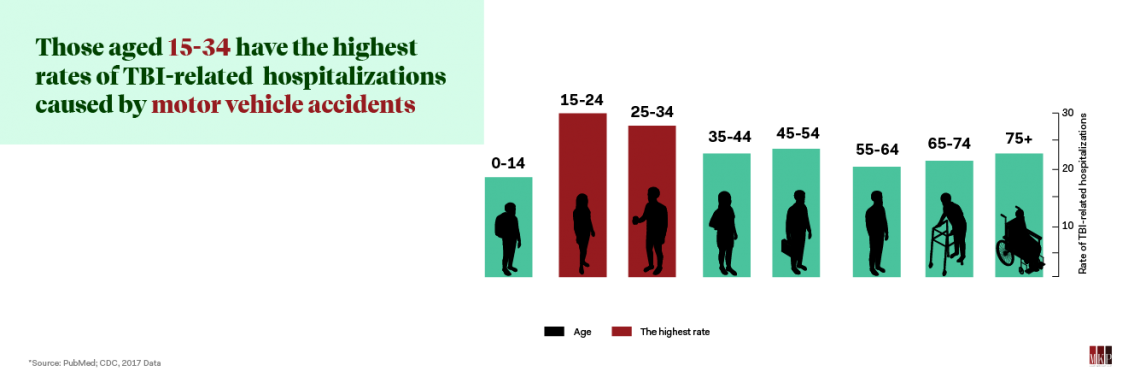
The group at highest risk for sustaining a vehicle-related brain injury is the demographic between 15 and 24 years at rate of 26.2, the next tier following it is 25 to 34 years at a rate of 22.6. (Source: CDC Surveillance Report for 2017)
8. Frontal lobe injuries are likely to happen during car accidents.
Car accident head injury statistics show that the frontal lobe is often affected during a motor vehicle accident involving rapid acceleration and deceleration. (Source: UMass Chan Medical School)
9. An estimated 46% of jail or prison inmates have a history of TBI.
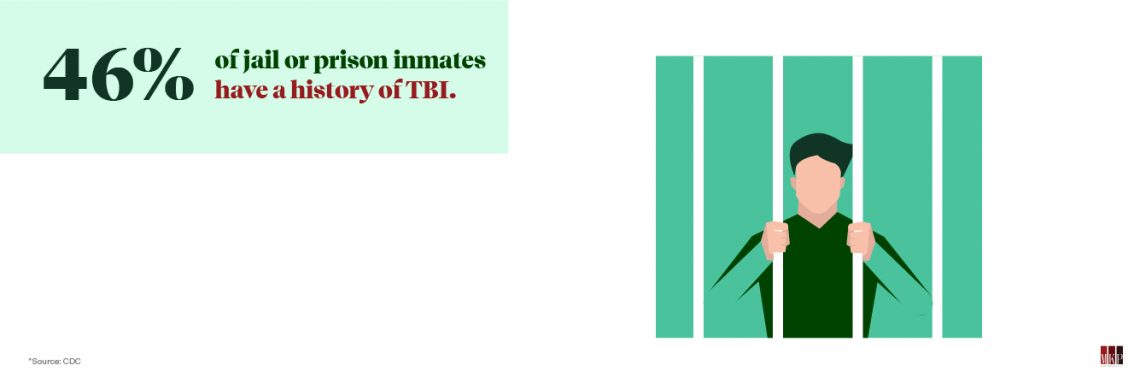
Research suggests an association between those in correctional or detention facilities and a history of a TBI. (Source: CDC Health Disparity and TBI)
10. TBI incidences in rural areas are more likely to end in death.
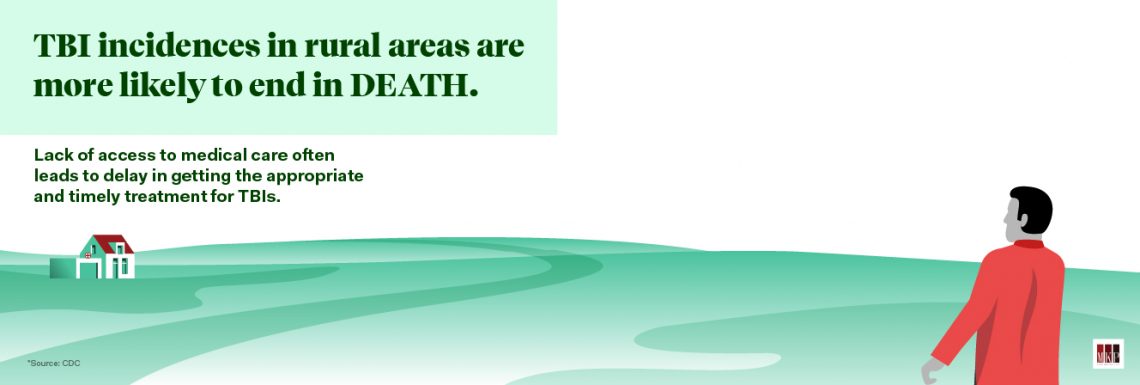
Unfortunately, rural areas don’t have quick access to medical care which often leads to delay in getting the appropriate treatment in a timely manner for TBIs. (Source: Health Disparity and TBI)
11. TBIs are expensive.
In 2000, estimated direct and indirect costs associated with traumatic brain injuries totaled $60 billion. (Source: BrainLine)
12. Bicycle-related TBI emergency department visits for kids have dramatically decreased in the last decade.

Between 2009 and 2018, increased helmet use and other safety measures have reduced TBIs for kids ages 10-14 by almost half the previous rates. Reductions in bicycle-related head injuries for kids in the past decade is 9x better than for adults. (Source: US News)
13. Sports-related head injuries tripled.
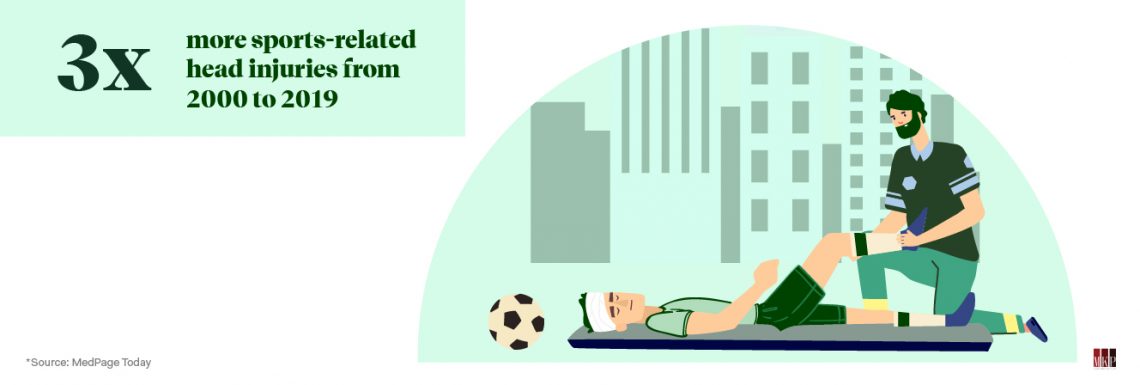
In the last two decades, emergency department reports of sports-related head injuries have more than tripled from 10,000 in 2000 to 30,000 in 2019. During this period 2000-2019, 40% of athletes aged 14-18 were female. (Source: MedPage Today)
14. Soccer and Basketball are responsible for the most sports-related head injuries in female patients.
Soccer (21%), Basketball (19%), Cheerleading (10%), Volleyball (7%), and Horseback Riding (5%) were responsible for the most female head injuries. (Source: MedPage Today)
15. The most at-risk ethnic group for TBIs: American Indians and Alaska Natives.
These two groups account for the highest rates of brain injury hospitalizations and fatalities: 71.5/100,000. (Source: PubMed)
16. Members of the armed forces made up about 400,000 TBI cases between 2000 and 2019.
Approximately 80% of these veteran TBIs occurred from injuries which occurred when the person was not deployed. (Source: Health Disparity and TBI)
17. California has a high number of TBIs.
As of 2014, the state had 32,838 non-fatal brain injury hospitalizations. (Source: California Department of Public Health
A Closer Look at Car Accident Head Injury Statistics
Between 1980 and 1994, there was a 38-percent reduction of fatal vehicle accidents. However, crashes involving motor vehicles, bicycles, and similar conveyances were responsible for 49% of all traumatic brain injuries. (Source: Report to Congress)
An expert’s perspective on the mechanism of brain injuries notes that there are primary and secondary traumas. Initially, there is the impact that includes a blow causing the brain to connect forcefully with the sides of the skull. Delayed trauma takes place when the brain settles back into place. It includes swelling, which reduces oxygenation. Types of TBIs include contusions, nerve damage, hemorrhage, and hematoma.
Specialists estimate that out of the adults and children suffering a brain injury, 1.1 million will have a mild case, whereas 235,000 will require hospitalization. Severe cases require EEG monitoring, since about 24% will respond to the TBI with seizures. If a stay at a rehab facility is needed, the patient may undergo three hours or more of daily rehab. (Source: Mayfield Clinic)
International Facts about Brain Injury
In a 2018 report, analysts found that each year, an estimated 69 million people globally sustain a traumatic brain injury. Motor vehicle accidents played a significant role in these crashes. However, the proportion differed by region. In North America, they accounted for 25% of cases. In Africa and Southeast Asia, they accounted for 56% in both regions.
That said, the overall rate of TBIs was the highest on a per capita count in North America. There were 1,299 cases per 100,000 residents. The figure was lowest in Africa, with 801 cases per 100,000 residents.
When measuring proportionality of TBIs, the brain injury facts pointed out that low and middle-income countries have three times the number of TBIs than high-income countries. Yet the researchers do make a note that the statistics may be flawed because of record-keeping differences among the regions. (Source: Estimating the Global Incidence of Traumatic Brain Injury)
